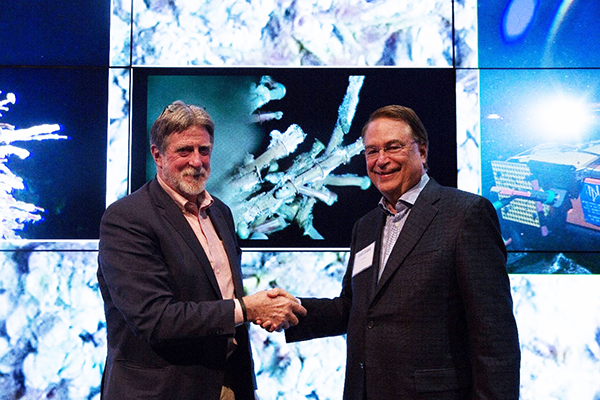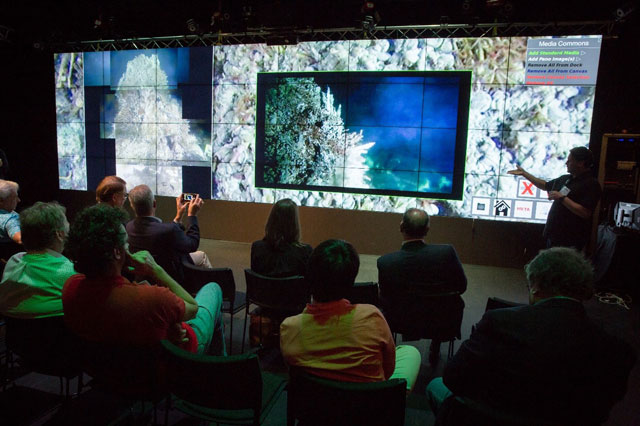

delivery of remote-controlled HD video live feed to large
display in Qualcomm Institute tiled display system.
CSE professor Larry Smarr began talking with University of Washington oceanographer John Delaney in 2004 about the possibility of deploying networked observatories deep on the ocean floor to observe interesting undersea ecosystems. Eventually they teamed on proposals funded by the National Science Foundation (NSF), including for the Ocean Observatories Initiative (OOI). Some 13 years after they first met, Smarr and Delaney were on hand to watch the first-ever live, public video transmission in high definition from a robotic camera and observatory roughly 1.5 kilometers (km) below the ocean's surface and approximately 400 kms offshore and due west of Astoria, Oregon.

Mushroom hydrothermal venting structure
captured at regular intervals by HD Video Survey
Delaney and Smarr - who also directs the California Institute for Telecommunications and Information Technology (Calit2) - watched the live feed in late October along with more than 120 other attendees at the 2017 National Ocean Exploration Forum (NOEF), hosted by Calit2's Qualcomm Institute at UC San Diego. The forum included a handful of high-tech demos, including the video feed from the 15-feet-tall active Mushroom hydrothermal vent 'chimney'. The demos were consistent with the meeting's theme, "Ocean Exploration in a Sea of Data."
The video feed, managed by UW's Delaney, portrayed in real time the biological and physical dynamics from the OOI Cabled Array observatory located near hydrothermal vents on the caldera of Axial Seamount, a live submarine volcano on the Juan de Fuca Ridge, a mid-ocean spreading center that separates the Pacific Plate to the west and the Juan de Fuca Plate to the east off the coast of Washington and Oregon. The site is so deep that, in the absence of the sunlight necessary for photosynthesis, a diverse community of organisms thrives on thermo-chemical outputs fed by water emerging from the ocean floor at up to 250 degrees Celsius. The real-time HD video feed was displayed on a large, 64-megapixel display wall in the Qualcomm Institute for viewing by NOEF attendees.
The OOI Cabled Array undersea observatory features 22 instruments, including CamHD, an at-sea robotic camera. Remote control of the camera augments the routine direct transmissions of pre-programmed video scans of Axial Seamount.

from ocean floor observatory in real time on UCSD 10 feet
by 36 feet display at QI.
For CSE's Smarr and UW's Delaney, the demo at NOEF was a long time coming. They first discussed prototyping remote, real-time interaction with sea-floor systems when they met at an NSF workshop in 2004. Originally conceived on a bar napkin at the 1991 meeting of the American Geophysical Union, Delaney's eventually launched the North East Pacific Time-series Undersea Networked Experiments (NEPTUNE) project. Then Smarr and Delaney collaborated on a 2004 NSF grant for the Laboratory for the Ocean Observatory Knowledge Integration Grid (LOOKING), which led in turn, in 2007, to a grant to build the OOI. Initial operation of the cabled observatory at Axial Seamount began in October 2014.

It was deeply gratifying," said Delaney, "to finally bring to fruition, before a distinguished group of ocean explorers, our long-sought-after vision of routinely interacting, in real time, with a variety of rapidly changing ecosystems operating more than 400 km offshore."
Smarr watched the stunning live video on the Qualcomm Institute's display wall with other attendees at the exploration forum, 13 years after he and Delaney first talked about deploying networked technology on the ocean floor.
"I stood there," recalled Smarr, "not really being able to believe that the dream John and I have had for so long was actually happening."
Read the complete news release about the live video demo from the OOI Cabled Array.

